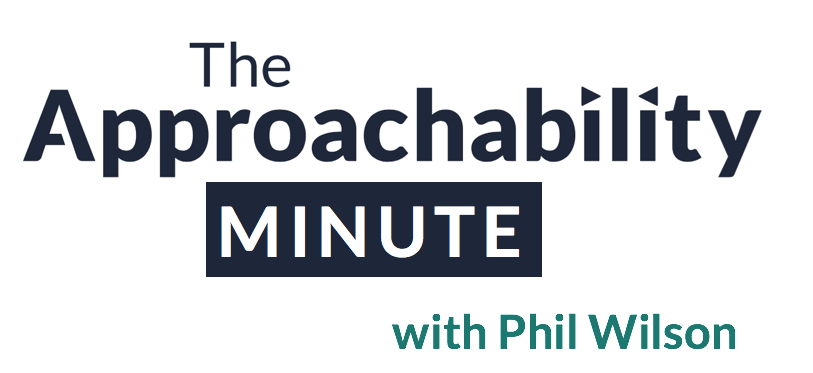
Small things make a big difference in what you achieve.
I recently read an article about Walt Bettinger, CEO of Charles Schwab. When he interviews someone he takes them to breakfast and asks the wait staff to get the order wrong on purpose. Then he watches the candidate react. Bettinger knows you can learn a lot about someone’s leadership by observing them talk to people in lower power positions. Are they respectful and courteous? Or are they short and talk down to them? Do they say “please” and “thank you”?
This idea is similar to the one behind The Achievement Habit, a book by Professor Bernard Roth, academic director and cofounder of Stanford University’s d.school. In his book, Roth discusses “how swapping simple words and phrases we are used to saying multiple times a day can reprogram the way we think about and view perceived obstacles that stand in the way of personal success.”
Changing the way we say things changes our behavior. This changes our lives. It’s pretty compelling. And I think it’s an appropriate concept to apply to leadership and your life.
Here are 5 of the top words and phrases Roth recommends we swap out to get past the mental roadblocks that our everyday word choices create.
- Use “and” instead of “but”: Roth states “We often use ‘but’ in place of ‘and’…This substitution is so common that it sounds correct. Unfortunately it often has the effect of changing a neutral statement into a negative one.” The idea here is that we often place “but” in between two truths. For example, “I want to go to the store, but I don’t like driving at night.” The second statement becomes an excuse. It creates conflict and places limitations on what is possible. If you replace “but” with “and” you are more likely to see possibility and search for solutions.
- Say “want to” instead of “have to”: Using the words “has/have to” implies that a situation has been forced upon us instead of “willingly chosen by us” – something that is almost always a misconception. Here’s an example from my own life. I often say “I ‘have’ to work out.” But that’s not true. If instead I say I ‘want’ to work out I am much more likely to do it. A corollary to that point: If I decide to skip my workout I should say “I chose to skip the gym” which requires more ownership than “I couldn’t get to the gym.”
- Use “won’t” instead of “can’t”: Most of the time when someone says they ‘can’t’ do something, it actually means they ‘won’t’ learn how. Roth writes “The simple change of ‘can’t’ to ‘won’t’ is often empowering…’Can’t’ implies helplessness; ‘won’t’ signifies volition and choice.” The other brilliant thing about this simple change is that it forces us to be explicit about these choices that we make many times each day.
- Say “I’d like to” instead of “I’m afraid to”: “I’m afraid to” is self-limiting. “It acknowledges the person’s fear instead of their desire.” Michael Grothaus, uses the example of asking for a raise in his FastCompany article. If you focus on being afraid to ask for a raise, you bring up further thoughts on why you’re afraid – my boss will think I’m greedy, maybe I’m not as good at my job as I thought. In essence, you bring up negative thoughts. Instead focus on why want a raise. What will it mean for your and your family? How will it also benefit the company? These are good feelings.
- Use “assist” instead of “help”: This one is my favorite and most applicable to the way we view our coworkers. To “help” someone implies that that person is incapable of accomplishing the task alone. To “assist” someone suggests that he or she is capable of doing it alone and that they are an important part of the solution. It affirms you and your coworker.
Our words have meaning. Little changes can have a big impact. Do you see how these small changes could change how you view yourself and what you can achieve in life? How could these changes in language (and behavior) improve your leadership? These phrases will improve your relationships with those you lead, and help them to see their own potential.
One of my favorite tools from our new book, The Approachability Playbook, is about creating the Right Space where employees feel comfortable and safe when approaching you. Creating the Right Space is about the little things you do that effect how you’re perceived by others. It’s not just the physical space you create or whether you are available. It’s also about the verbal and behavioral space.
Are the words you say to those you lead empowering them or keeping them down? Do you listen for and assist others with changing their self-limiting talk? These are little things that matter a lot. And they are easy to overlook during a busy day. Be a leader who achieves by looking for ways to assist your coworkers with knocking down their mental roadblocks. Your teammates will thank you.
What do you think about Professor Roth’s idea of how our words change our reality? Do you think the same is true in leadership? Can you think of any little things you do or say that might be pushing those you lead in the wrong direction?

Not everyone wants to lead others.
When you were promoted to a leadership position did anyone ask, “Do you want to lead others?”
It’s an interesting question. What if your truthful answer is no – would you be honest? Because in most companies if you don’t want to lead others you’re stuck. You don’t get the promotion. You don’t get the raise (although often that first level leader position becomes a pay cut if you don’t qualify for overtime). You aren’t considered a team player.
This is what causes people who don’t really want to lead others to accept leadership positions anyway. If they say no their growth opportunities vanish. What growth opportunities does your company give workers who don’t want managerial positions?
Imagine your outside salesperson is amazing at her job. She’s the best you have. She has great relationships with the customers and coworkers. She consistently brings money in. She is sharp. Rarely does she make a mistake. To you, she is the most deserving of the open management position you are trying to fill. So you offer her the job.
She is excited and grateful, you can tell. But she’s a little hesitant. What would transitioning into a leadership role mean for her? It would mean being in the office all the time instead of getting out in front of customers (who are now her friends). It means a lot more paperwork (thinking about this makes her wince). It means she’s responsible for solving interoffice drama and dilemmas instead of taking her usual route and keeping her distance. It means being in charge of budgets and inventory, discipline and process sheets. In essence, it would mean being promoted right out of doing the things she loves.
What happens next? Disengagement.
And as report after report shows, lack of engagement is a dead weight on your company…it’s also not great for the disengaged employee.
One organization, Saatchi & Saatchi Wellness, recognized this paradox at their own company and created something called a “craft track.” The craft track “recognizes the creative output and hard work of team members by giving them an alternative means of gaining raises and promotions, while still practicing their craft.” In my experience most organizations don’t have a system set in place for people like this. Can you create something like this at your company? Is there a way for people who don’t want to be leaders to continue to grow and develop at their craft? Or is leadership the only path to advancement in your company?
Your company may be small like ours. Maybe all your positions are “craft track” positions. Or you may promote several people to leader positions each month. Either way, what is most important is making sure you focus on each individual’s goals and aspirations before you push them toward one track or the other. Build relationships and get to know your coworkers (our new book has more than a few suggestions). The more you focus on enriching relationships with people, the more obvious it is who will thrive where.
In our consulting practice we see a lot of damaged workplaces. Often at the center of these problems is a leader who really isn’t suited for the role and who never really wanted to lead others in the first place. Moves like this are a great way to lose top talent (in the example above you lose your best salesperson and gain a terrible sales manager). Make sure that your company doesn’t make this classic error. Grow and develop leaders who want to lead others instead of forcing people into leadership roles they don’t want in the first place. Your team will thank you.
Have you ever promoted the wrong person in a leadership role? Looking back, was there a developmental opportunity that would have been better suited that individual? What can you do in your own organization to create promotion opportunities for employees who aren’t interested in leadership?

Leaders are readers.
This is a truth affirmed over and over again by the great leaders of the world – Abraham Lincoln, Teddy Roosevelt, Winston Churchill, Ghandi – but the one that got me recently was John W. Gardner.
Gardner was “a legendary public intellectual and civic reformer – a celebrated Stanford professor, an architect of the Great Society under Lyndon Johnson, founder of Common Cause and Independent Sector.” Gardner passed away nearly 15 years ago. But lucky for me, the other day I stumbled upon an HBR article that discussed a speech Gardner gave back in 1990. He said:
“We have to face the fact that most men and women out there in the world of work are more stale than they know, more bored than they would care to admit…Boredom is the secret ailment of large-scale organizations. Someone said to me the other day ‘How can I be so bored when I’m so busy’ I said ‘Let me count the ways.’ Look around you. How many people whom you know well – people even younger than yourselves – are already trapped in fixed attitudes and habits?”
He goes on to provide the antidote to boredom…
“Be interested…Everyone wants to be interesting, but the vitalizing thing is to be interested…As the proverb says, ‘It’s what you learn after you know it all that counts.'”
So much wisdom there. My summary: Curiosity is THE killer app.
It’s hard to accept that your people (or you) are bored. After all, everyone is working hard and they’ve got a good gig. We can provide for our families. We are secure. But this is precisely what feeds boredom. You wake up and it’s Groundhog Day all over again. You’re grateful, busy, and moving. But that doesn’t stop boredom from creeping in.
How can leaders keep boredom at bay?
Start with you. Fight your own boredom. Don’t be boring. Lead by example. Be curious. Remain interested in the future. In new ideas. In our people.
This curiosity, energy, passion, and excitement is what kills your own boredom. And it is really hard to stay bored around people who aren’t boring. Boom. You’re curing the boredom of everyone around you.
Where do we start? I start with books. Physical books. E-books. Audio books. Podcasts. Whatever works for you.
To try to get you started, here are 20 books. These are the last 10 books I read, plus 10 new leadership books I’m adding to my bookshelf:
My Last 10 Books
- Don Quixote by Miguel Cervantes (re-reading it now after finishing Bauer’s book)
- The Well Educated Mind by Susan Wise Bauer
- Superbosses by Sydney Finkelstein
- Good Profit by Charles Koch
- Unstuck! by Kenyon Blunt
- Egonomics by David Marcum and Steven Smith
- Letters from a Stoic by Seneca
- Living Forward by Michael Hyatt and Daniel Harkavy
- Fierce Conversations by Susan Scott
- The Score Takes Care of Itself by Bill Walsh
10 New Leadership Books
I ran across a great article listing new leadership books – many of these I hadn’t heard of and I’ve already added most of them to my Kindle bookshelf (list courtesy of smallbiztrends.com):
- The Directors Manual: A Framework for Board Governance by Peter C. Browing and William L. Sparks
- The Leadership Capital Index: Realizing the Market Value of Leadership by Dave Ulrich
- Negotiating the Nonnegotiable: How to Resolve Your Most Emotionally Charged Conflicts by Daniel Shapiro
- The Strategy Book: How to Think and Act Strategically to Deliver Outstanding Results by Max Mckeown
- The Attacker’s Advantage: Turning Uncertainty into Breakthrough Opportunities by Ram Charan
- The Coaching Habit: Say Less, Ask More & Change the Way You Lead Forever by Michael Bungay Stainer
- The Productivity Project: Accomplishing More by Managing Your Time, Attention, and Energy by Chris Bailey
- Discover Your True North by Bill George
- The Big Fish Experience: Create Memorable Presentations That Reel In Your Audience by Kenny Nguyen, Gus Murillo, Robert Killeen, and Luke Jones
- Life is Good: The Book by Bert Jacobs and John Jacobs
Last but certainly not least I’ve been reading (and editing) one other book quite a bit over the last few months – my new leadership book:
The Approachability Playbook: 3 Essential Habits for Thriving Leaders and Teams
I’m biased, but I think it’s pretty great 🙂
What leadership books are on your shelf? Have you read any of the ones mentioned above? What’d you think? Let us know in the comments!

What’s your leadership style?
Last month Entrepreneur published an interesting article that describes six different leadership styles.
The styles were described by Tor Cosantino, who assessed himself as a Pacesetter, only to find out that his peers classified him as a very different type of leader, a Visionary. By the way, I really respect leaders who publicly admit when they get something wrong. The world could use a lot more leaders like that.
What’s the difference between a Pacesetter and a Visionary leader? We’ll get to that. First I want to discuss the unicorn in the room – “we are not the best to measure our own leadership skills and gaps.”
This is a hard thing to accept sometimes, especially for those of us in power roles. We’re (usually) in these positions because we’re capable and good at seeing the big picture. We have a lot of experience in our business – it helps us gain perspective. But we are human. Even if we have good perspective about our business, we often are way too close to ourselves to have any perspective about our own leadership. This lack of self awareness is the downfall of many leaders.
How do we make time to get an outside perspective about our leadership style?
One thing we know about power distance is that you are very unlikely to get an honest, outside perspective unless you ask. You have to make it safe for others to give you feedback. They must feel comfortable speaking honestly, not worried that you’ll kill the messenger.
This is the only way to truly know what is happening in your organization, especially if you want to know in time to do anything about it. And it is the only way to know what type of leader your followers think you are (versus the kind of leader you think you are).
On to the assessment Tor took with his team. This assessment, conducted by The Hay Group, narrows down leadership into six styles:
- Directive. The “my way or the highway” leader who “seeks to gain immediate compliance, relying on the use of ‘orders’ rather than providing context and direction.”
- Visionary. “The Visionary provides an authoritative perspective regarding the business’ prospects, as well as why that perspective matters and how every individual can work towards making it a reality.”
- Affiliative. “The Affiliative mode of leadership focuses on people and relationships with a primary goal of creating trust and harmony across the organization. A lot of attention is given to meeting the needs of the individuals without placing a priority on performance or results.”
- Participative. “The Participative approach to leadership seeks to engage others in the leadership process. A key objective of this style is to generate new ideas and solutions from a team using consensus and commitment.”
- Pacesetting. These leaders “tend to have high performance standards and work hard to ensure those standards are met. They also tend to lead by example; however, they can be reluctant to delegate.”
- Coaching. “Leaders who rely on the Coaching method strive to identify the unique [strengths] and weaknesses of their team members with the end goal of helping those individuals develop the behaviors and skills to meet their professional objectives.”
Overall, it’s a pretty good list. It captures many of the common leadership styles. But I think most would agree that the best leaders don’t have just one style. Instead they adjust based on the circumstances – at least that’s what approachable leaders do.
You probably have a natural leadership tendency that is captured by one of the 6 styles listed above. Knowing your “base” leadership style is a solid first step. Then do what Tor did – ask around and see if others agree with your assessment. Once you learn your natural style you can begin working to embrace the qualities of some of the others.
The key is to find a balance in your leadership style.
Being directive is great when it’s necessary. When things are crazy or you are dealing with someone who is new, your direction will be welcomed. If you are naturally more of an affiliative leader, you probably need to get comfortable taking control and directing the team when the time calls for it.
The naturally directive leader also needs to flex. Directive leaders can fall flat on their face if they order people around when things are humming or they are bossing around workplace veterans. This kind of leadership will make your team run the opposite direction.
Leaders with a “my way or the highway” tendency will need to focus on developing relationships with their employees (like the affiliative leader). What they’ll discover is that there are qualities about each individual that motivates them to work. Over the long run you can’t engage and motivate through ultimatum.
You may have to use any of the six (or more) different styles depending on the situation. Does that sound complicated? Don’t worry. Let me give you a short cut.
Approachable Leaders don’t worry about figuring out the “right” leadership style. Instead they let their teammates tell them what style they need at that time. How do they make that happen? By asking the three questions of approachable leaders:
- Do you have what you need?
- What would make work better?
- Where are you going?
If you ask questions like these your employees will let you know what kind of leadership they need (if any). Listen carefully to what your followers say. Then take action. Your leadership style will take care of itself.
Which one of these six leadership styles do you think you fit into the most? What about the leader you most admire? Are there qualities about that leader you’re missing in yourself? How do you think your employees would answer that question? You can download our three questions tool FREE in our Approachable Leadership Toolkit.

[youtube https://www.youtube.com/watch?v=fVsF8URgj6A]
Human preferences change over time. This is the major critique the Austrian School of economics makes against the Keynesian School. Which brings us to the nerdiest t-shirt I own. It also brings up an important point about leadership.
Do you have any preferences that have changed in recent years? Have you considered how your employees evolve over time as well? What do you do to keep up with who they are and where they want to go?
















